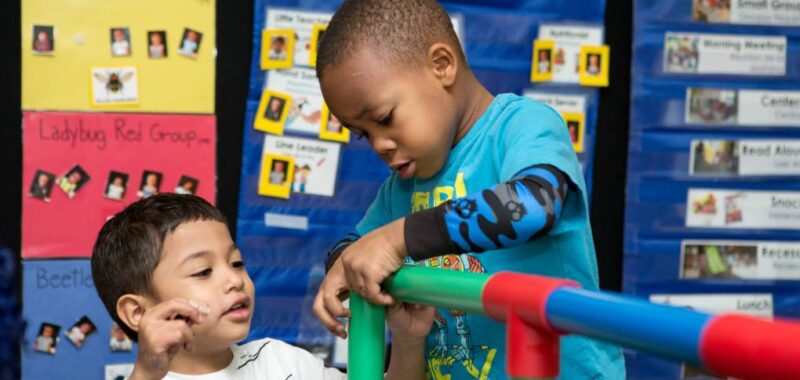For example, if a teacher is focused on guiding students through creating a story using a sequence of events, they may offer students the option to draw their story, use a variety of materials to construct it or engage in dramatic play to act it out. “These all bring us to the standards, but they bring us there in a way that leverages kids’ natural inclinations to play,” said Mraz. She recommended Susan Harris MacKay’s book Story Workshop as a resource for using play to meet learning standards related to storytelling
Mraz also encouraged teachers to be flexible. Initially, she required students to select a path and stick with it. However, she has since realized that being adaptable can improve student engagement and creativity. “Some days [students] just might need to move around, or sometimes doing something in one area actually inspires [them] in another area,” she said.
Gathering: Construct ideas
After students have played, the gathering phase provides time for students to share their thoughts, reflect on their experiences and collaboratively build knowledge. Mraz suggested that students sit in a circle for this phase. Teachers may guide students to explore various content areas, reflect on themes from the play, address problems that came up or discuss the materials being used. “In order to construct knowledge, you have to have opportunities to process it with people,” Mraz said.
In one class, Mraz used gathering time to talk about different ways to share materials. Students identified different sharing strategies they used during their play, such as taking turns, splitting items or finding additional materials. Mraz created a chart with these strategies and asked if any students had experiences that could be addressed with those ideas. The activity built on students’ reading and problem-solving skills, Mraz said.
To help teachers build their facilitation skills, Mraz recommended Hands Down, Speak Out: Listening and Talking Across Literacy and Math by Kassia Omohundro Wedekind and Christy Hermann Thompson. “[It’s] a brilliant text on how to develop these circle conversations in your classroom with tons of practical strategy,” said Mraz.
Clean up: Collaborate toward a shared goal
The clean-up phase of the play workshop structure is not merely about tidying up but about instilling a sense of responsibility and cooperation. While the usual approach might have each child cleaning up their own play area, Mraz suggested organizing clean-up to reflect how it works in the real world. For example, in a family, clean-up tasks are often shared: One person might clear the table, another might wash the dishes and another might dry them. Students can follow a similar structure.
Instead of “clean up your own mess,” Mraz uses the message, “our community works to make our space clean.” She assigns specific roles to small groups of students, such as table wipers, block cleaners and a timer setter. “Every child is able to contribute to clean up in a way that plays to their strengths,” she explained.
Mraz acknowledged that while play-based learning is familiar to many early childhood educators, incorporating these strategies can be daunting for teachers who rely on traditional methods. Even small shifts can make a significant difference, she said. “Is there one small movement you can make that brings us closer to a world that values children in their natural state, so that children grow to be the people who value one another in their natural state?”

